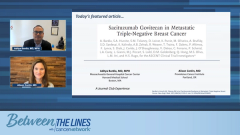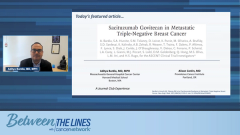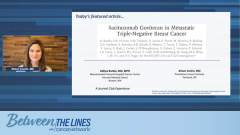
Metastatic Triple-Negative Breast Cancer: Unmet Needs and Future Directions in Care
Expert oncologists highlight remaining unmet needs in the setting of metastatic triple-negative breast cancer and look toward future evolutions in care.
Transcript:
Alison Conlin, MD: What do you think the next studies will be? What’s the next step is in this work?
Aditya Bardia, MD, MPH: That’s a good question. In terms of expansion of sacituzumab govitecan and other studies, the first would be other subsets of breast cancer. TROP2 is also expressed in hormone receptor-positive breast cancer. There was a clinical trial called TROPiCS-02, looking at sacituzumab govitecan vs standard chemotherapy in later lines. That trial required patients to have at least 2 prior lines of chemotherapy, so it was more of a third- and fourth-line chemotherapy study but in the hormone receptor–positive metastatic breast cancer setting. That trial showed an improvement in progression-free survival. At ESMO [European Society for Medical Oncology Congress] this year we saw improvement in overall survival from the TROPiCS-02 trial in patients who had received sacituzumab govitecan vs standard chemotherapy. The company has filed for approval. We’ll see if the drug gets approved for patients with hormone receptor–positive metastatic breast cancer. There’s also interest in moving the drug in early breast cancer to prevent metastatic disease. It will be interesting to see if these ADCs [antibody-drug conjugates] make their way in early breast cancer as well as an agent that could be more effective and less toxic for our patients with breast cancer.
Alison Conlin, MD: Another group in need is those who don’t achieve pathologic complete response after neoadjuvant and very high-risk disease in those following few years. The other area I’m hoping to see some data on would be a combination in an earlier-line setting with immunotherapy. In our subset of patients with TNBC [triple-negative breast cancer] who have some immune expression, adding first-line immunotherapy can be very helpful. I’m hoping to see some combination in the future of these agents.
Aditya Bardia, MD, MPH: That’s a great point. To build on this, there’s a trial called ASCENT-04, looking at sacituzumab govitecan plus pembrolizumab vs standard chemotherapy plus pembrolizumab as a first-line therapy option for patients with metastatic TNBC, because there’s interest combining these agents with immunotherapy agents.
Alison Conlin, MD: That will be great.
Aditya Bardia, MD, MPH: What are the other unknown questions or unmet needs in the field of breast oncology in general and triple-negative breast cancer more specifically?
Alison Conlin, MD: Thinking about how to treat our early-stage patients and how to de-escalate therapy, the standard is a 4-drug regimen for patients with stage II or III triple-negative breast cancers. Perhaps we can find those who need less and those who need more because of residual disease or resistant disease. Maybe all our traditional chemotherapies aren’t the way to go for some of those patients. It’s substantial toxicity for patients with the goal of staying cured. It’s interesting that a good percentage of later-line patients did not have TNBC as their initial therapy and developed that as metastatic disease. Those patients also benefited from sacituzumab govitecan. I’ve recently seen some of these in my practice. Their tumor must have been heterogeneous. I’m curious how this is happening to these patients? Do we treat optimally their estrogen subcomponent? Then we’re left with some more aggressive disease. I’d like to better understand the biology of those patients.
Aditya Bardia, MD, MPH: That’s a great point. It’s an unmet need in the field. We need better understanding about whether these tumors that are ER [estrogen receptor]–positive and then become triple negative. Can they become ER+ again in the future? Understanding these components would be very valuable. You brought up a good point about neoadjuvant. I fully agree. We use KEYNOTE-522, but that has 5 drugs: carboplatin, Taxol [paclitaxel], anthracycline, Cytoxan [cyclophosphamide], and immunotherapy. Maybe these ADCs can help us de-escalate the number of chemotherapy agents we have to use.
Alison Conlin, MD: There’s so much overlap in toxicity with the traditional chemotherapy agents. ADCs have some of those toxicities, but it would still be nice to reduce it, particularly the neuropathy with the carboplatin and taxanes that isn’t present with sacituzumab. That's 1 example of something we may be able to help patients with.
Aditya Bardia, MD, MPH: It’s a great start with these ADCs. Hopefully over the next 5 to 10 years we’ll see further improvement in outcomes for our patients.
Alison Conlin, MD: Absolutely. I tell my patients these are all our new drugs. They’re all ADCs, and they’re great.
Aditya Bardia, MD, MPH: Great, thank you so much. I hope this was helpful. This was a deep dive into the ASCENT trial. We reviewed antibody-drug conjugates and future directions. Thank you for joining.
Alison Conlin, MD: Thank you.
Transcript edited for clarity.
Newsletter
Stay up to date on recent advances in the multidisciplinary approach to cancer.





















































































